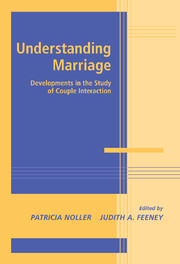Book contents
- Frontmatter
- Contents
- Contribitors
- Introduction
- SECTION ONE THE EFFECT OF COGNITION ON INTERACTION PATTERNS
- SECTION TWO UNDERSTANDING THE IMPORTANCE OF POSITIVE INTERACTION
- SECTION THREE COPING WITH DISAPPOINTMENT, CRITICISM, AND BETRAYAL
- SECTION FOUR POWER, CONFLICT, AND VIOLENCE IN MARITAL INTERACTION
- Marital interaction at important transition periods
- SECTION SIX Interventions for strengthening relationships
- Conclusions
- Index
- References
Introduction
Published online by Cambridge University Press: 25 July 2009
- Frontmatter
- Contents
- Contribitors
- Introduction
- SECTION ONE THE EFFECT OF COGNITION ON INTERACTION PATTERNS
- SECTION TWO UNDERSTANDING THE IMPORTANCE OF POSITIVE INTERACTION
- SECTION THREE COPING WITH DISAPPOINTMENT, CRITICISM, AND BETRAYAL
- SECTION FOUR POWER, CONFLICT, AND VIOLENCE IN MARITAL INTERACTION
- Marital interaction at important transition periods
- SECTION SIX Interventions for strengthening relationships
- Conclusions
- Index
- References
Summary
Seldom or never does a marriage develop into an individual relationship, smoothly and without crises. There is no birth of consciousness without pain.
—C. G. JungA great deal of publicity has been given to the fact that more adults in western societies are remaining single than in the past, and that rates of cohabitation are continuing to rise. In fact, some writers have gone so far as to extrapolate from these recent trends, and to conclude that marriage is becoming an unpopular and outdated institution. Nevertheless, studies show that most young people still see marriage and children as an important part of their future, and still view marriage as playing a crucial role in meeting their needs for companionship and emotional security.
Consistent with this viewpoint, Waite and Gallagher (2000) present empirical support for the proposition that there are several major advantages to marriage. First, married men and women tend to enjoy better mental and physical health than the unmarried. Second, married men and women are likely to have more assets and income than the unmarried, with marriage even being described as a “wealth-enhancing institution” (Hao, 1996). Third, married people have more and better sex than the unmarried. Fourth, children of married parents also enjoy a number of advantages, including better physical and mental health, and higher levels of education and career success.
Information
- Type
- Chapter
- Information
- Understanding MarriageDevelopments in the Study of Couple Interaction, pp. 1 - 6Publisher: Cambridge University PressPrint publication year: 2002
